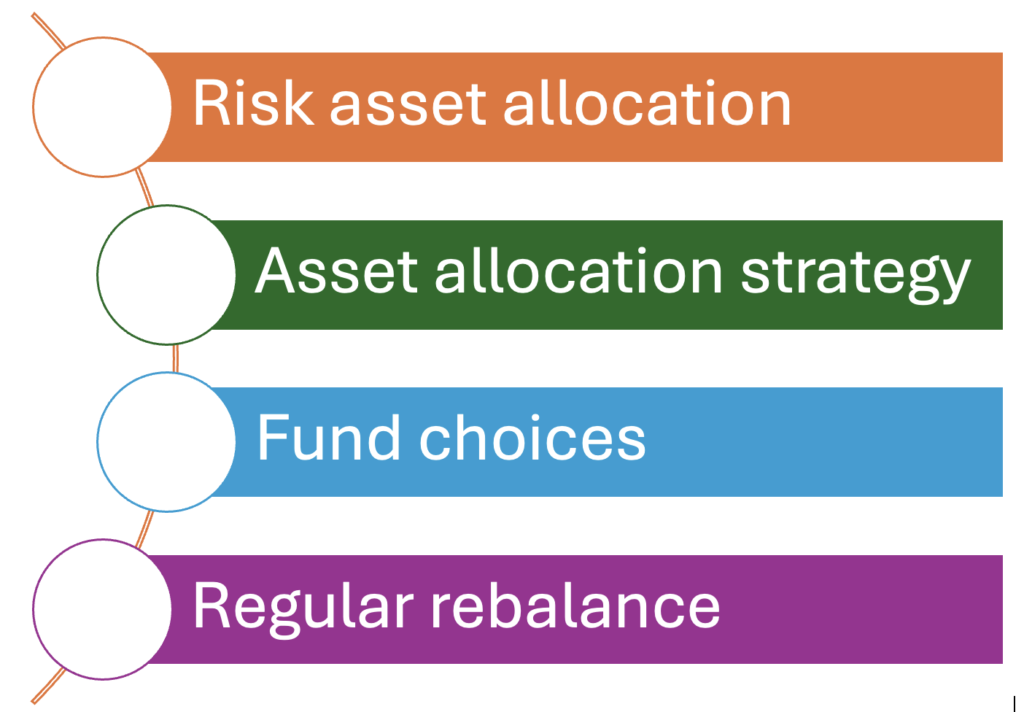Navigating the complex world of 401(k) retirement investing can be daunting, especially when faced with many investment options. However, by following these four simple steps, you can strategically plan your investments and maximize your returns. Let’s delve into each step to ensure you make informed decisions for a secure financial future.

Step 1: Decide your risk profile and investment time horizon
Before delving into the array of investment options or funds given in your plan, it’s crucial to define your risk profile and investment horizon. Consider the following sub-steps:
- Assess Your Risk Tolerance: Evaluate your comfort level with market fluctuations by examining your risk tolerance. Comprehend the correlation between risk and return, bearing in mind that increased risk frequently results in higher long-term returns. Generally, the investment options within your plan can be categorized into risk assets and fixed income. Risk assets encompass stock funds, Real Estate Investment Trusts (REITs), and commodities. These funds or assets often demonstrate considerably higher volatility compared to other investments such as bonds, short-term investments, and cash (including money market funds and stable value funds). Historically, stocks have shown volatility levels 3 to 5 times higher than that of bonds. It’s worth noting that certain bond funds should also be regarded as risk assets. This includes long-term bond funds, foreign (particularly emerging market bond funds), and high-yield bond funds. The percentage allocated to risk assets is commonly referred to as the risk profile. For instance, if your account has 65% allocated to stocks and REITs, the risk profile for the account is 65.
- Analyze Your Investment Horizon: Evaluate how long you intend to keep your investments in your 401(k) account. Longer investment horizons may warrant a more aggressive approach, as they allow you to ride out market fluctuations and capitalize on the potential for higher returns.
- Allocate Your Investments: Divide your investments based on your risk profile. Common allocations include:
- Aggressive Growth: 90% or more in stocks and risk assets
- Growth: 80% or more in stocks and risk assets
- Moderate: Around 60% in stocks and risk assets
- Conservative: Approximately 40% in stocks
- Very Conservative: About 20% in stocks
- Utilize Risk Profile Calculator: Explore our risk asset allocation calculator to simplify the decision-making process and align your portfolio with your risk tolerance and investment horizon. The calculator presents several simple ways to decide your risk profile.
Once you have decided how much your risk asset allocation should be, the next step is to pick an asset allocation.
Step 2: Asset allocation strategy
Now that you’ve defined your risk profile, the next step is to determine the allocation of assets within your chosen risk profile.
- Understand Asset Allocation: Learn the significance of asset allocation – the distribution of your investments among different asset classes. Balance your portfolio to mitigate risk and optimize returns by diversifying across stocks, bonds, real estate, and cash.
- Diversify for Stability: Spread your investments across various asset classes to reduce risk and enhance stability. This approach ensures that a downturn in one sector does not significantly impact your overall portfolio.
A straightforward yet effective approach to determining asset allocation is to select a template from various well-known lazy portfolios recommended by investment experts. These templates have been widely used by financial advisors and investment managers. Subsequently, adjust the risk asset allocation based on your risk profile. For further details, refer to Asset Allocation Portfolio Templates.
Note: The asset allocation template you choose should align with the investment options available in your 401(k) plan. For instance, if your plan offers only US stock and bond funds, you will need to select a template that accommodates these two asset classes.
Step 3: Choices of funds or investment options
For each asset class you choose to invest, you’ll need to decide what funds in this asset class in your plan’s avaiable investment options to invest. There are several simple criteria one should follow:
- Fund expense ratio or cost: the lower the expense ratio is, the less your investment return will be impacted.
- Diversification: broad base index funds, especially in stocks, can be more stable than concentrated holdings. In general, for average investors, it’s recommended to choose broad base stock index funds.
- For bond or fixed income investments, some excellent bond funds, if availablel in your 401(k) plans, can deliver higher returns with comparable risk.
Step 4: Regular rebalance
Set up a schedule for regular portfolio reviews and rebalancing to ensure that your asset allocation remains aligned with your long-term financial goals. It’s recommended to be cautious about excessive rebalancing, as it can potentially harm your investment returns, especially when done without a systematic and sound strategy. For the average investor, an annual rebalancing approach could be a prudent choice.
Refer to the AAII (American Association for Individual Investors) article Selecting Asset Classes for Retirement Investments for more discussions on asset classes and fund choices.
Disclaimer: The information provided above is for educational purposes only. If your specific situations require it, it is advisable to consult with a financial advisor or a professional to address your individual needs and circumstances.
